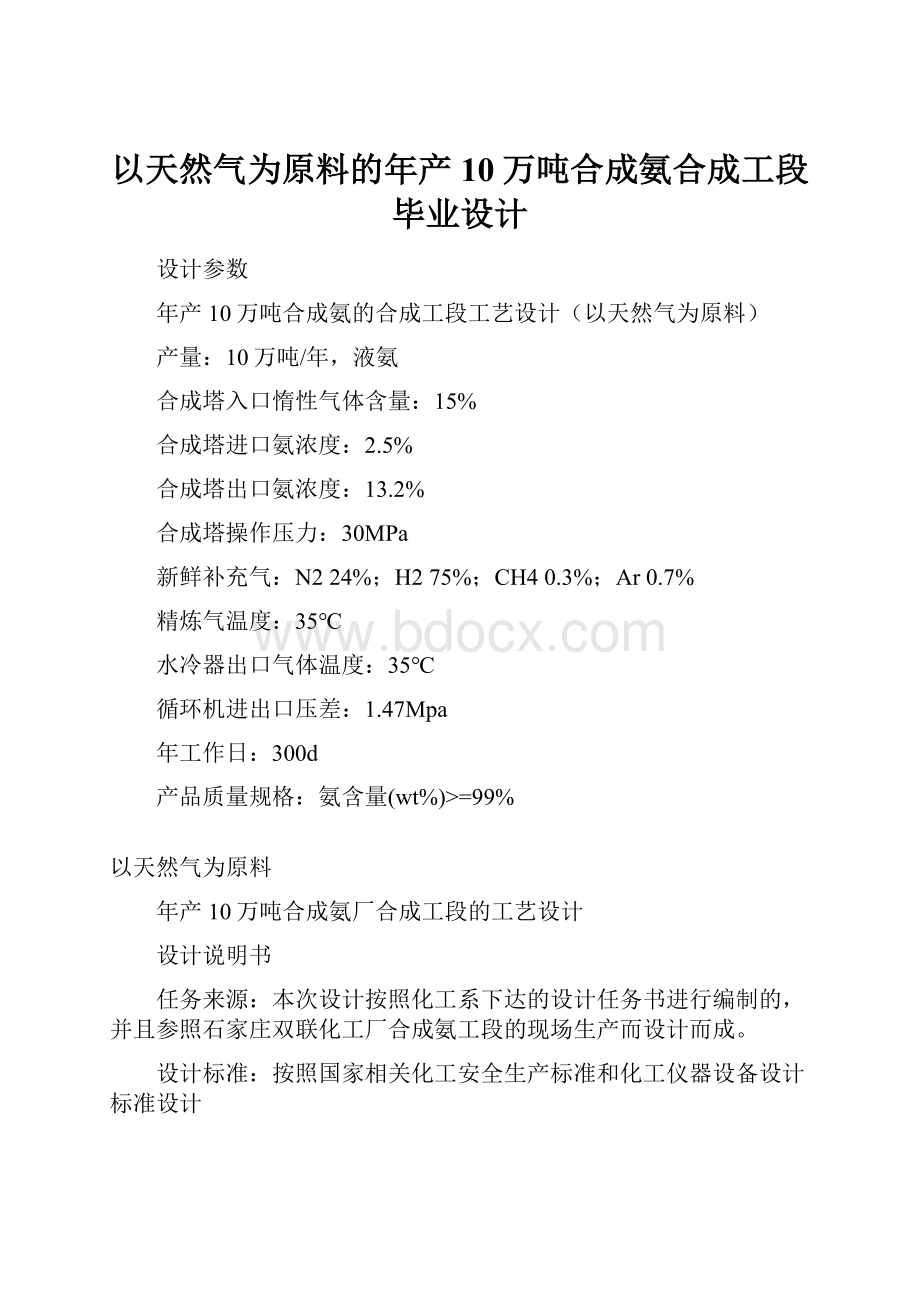 以天然气为原料的年产10万吨合成氨合成工段毕业设计.docx
以天然气为原料的年产10万吨合成氨合成工段毕业设计.docx
- 文档编号:10967787
- 上传时间:2023-02-24
- 格式:DOCX
- 页数:86
- 大小:284.43KB
以天然气为原料的年产10万吨合成氨合成工段毕业设计.docx
《以天然气为原料的年产10万吨合成氨合成工段毕业设计.docx》由会员分享,可在线阅读,更多相关《以天然气为原料的年产10万吨合成氨合成工段毕业设计.docx(86页珍藏版)》请在冰豆网上搜索。

以天然气为原料的年产10万吨合成氨合成工段毕业设计
设计参数
年产10万吨合成氨的合成工段工艺设计(以天然气为原料)
产量:
10万吨/年,液氨
合成塔入口惰性气体含量:
15%
合成塔进口氨浓度:
2.5%
合成塔出口氨浓度:
13.2%
合成塔操作压力:
30MPa
新鲜补充气:
N224%;H275%;CH40.3%;Ar0.7%
精炼气温度:
35℃
水冷器出口气体温度:
35℃
循环机进出口压差:
1.47Mpa
年工作日:
300d
产品质量规格:
氨含量(wt%)>=99%
以天然气为原料
年产10万吨合成氨厂合成工段的工艺设计
设计说明书
任务来源:
本次设计按照化工系下达的设计任务书进行编制的,并且参照石家庄双联化工厂合成氨工段的现场生产而设计而成。
设计标准:
按照国家相关化工安全生产标准和化工仪器设备设计标准设计
设计原则:
本设计的原则是以绿色化工为准则,低耗能、低成本、无污染的原则。
设计的主要内容及特点:
本工段生产液氨,生产能力为10万吨液氨/年,与传统的流程相比较具有节能低耗的特点。
在废热锅炉和水冷器之间设计一个热交换器,通过热交换器回收了废热锅炉出来的气体中剩余的热量并同时为原料气进行了预热,另外也进一步降低了合成气的温度,为对后续的冷凝工作有利,间接的节约了消耗的热量和冷量。
现将具体的设计内容介绍如下:
(1)循环机位置
本工段循环机设置在氨分离系统后,合成塔之前,从而充分利用循环机压缩功,提高进合成塔温度,减少冷量消耗,降低氨冷器负荷,同时提高进塔压力,提高合成率,而进循环机的氨冷量较低,避免了塔后循环机流程容易带液氨而导致循环机泄漏。
(2)反应热回收的方式及利用
热量的回收主要集中在合成塔处,这里涉及到废热锅炉的热量回收利用和合成塔塔外换热器如何科学设置的问题,废热锅炉的配置实际上是如何提高反应热的回收率和获得高品位热的问题,本次设计选择的是塔后换热器及后置锅炉的工艺路线,设置塔后换热器使废热锅炉出口气体与合成塔二进气体换热,充分提高合成塔二进温度,相应提高了合成塔二出温度,进废热锅炉的气体温度为365度,副产1.372兆帕的中压蒸汽,充分提高回收热量品位。
(3)采用“二进二出”合成流程
全部冷气经合成塔的外围环隙后进入热交换器,可使合成塔塔体各点温度分布均匀,出口气体保持较低温度,确保合成塔长期安全稳定运行,与循环机来的冷气直接进入热交换器相比,使热交换器出口温度增大。
进入水冷的气体温度降低意味着合成余热回收率高和水冷器的负荷低。
(4)水冷器和氨冷器的设置
水冷后直接进行分离液氨然后再进行冷交,水冷有利于降低后续氨冷的负荷,边冷却边分离液氨,即提高了液氨的分离效果,又避免了气液两相流的存在,通过设置氨冷器的冷凝充分解决了低压下,水冷后很少有氨冷凝下来的矛盾,达到了进一步冷却,保证合成塔入口氨含量的要求。
(5)新鲜气及放空点位置设置
新鲜气的补充设置在冷交换气的二次入口,以便减少系统阻力,并通过氨冷器进一步洗脱微量二氧化碳和一氧化碳及氨基甲酸等杂质,有利于保护触媒、防止管道和设备堵塞。
放空点设置在冷交换器和氨分离器之间,氨分后有效气体浓度较低,惰性气体含量较高,有利于降低新鲜气单耗。
(6)冷交换器设备的使用
分离器为外向型旋流板,上部换热器为列管换热器和下部氨分离器,将热气体在进入氨冷器前用冷气体进行冷却换热,以回收冷气体的冷冻量,使入氨冷器的热气体预冷却,从而节省冷冻量,同时分离经氨冷后含氨混和气中的液氨,安徽淮南化工公司发表与《小氮肥》杂志上的有关资料表明,该设备节能降耗显著。
(7)三废治理及环境保护
①放空气弛放气送膜提氢回收系统,先用氨洗涤塔回收几乎全部氨,制成浓氨水,再回收大部分氨送入高压机压缩后制氨既可以避免氨气进入大气,与放空气作燃料相比又更合理经济。
②其他废水废渣集中处理达到国家排放标准后排放。
(8)生产制度:
每年操作日300天,三班连续操作。
(9)结论
本设计主要是对于合成氨的工艺流程的设计;其中包括合成氨各主要工段设备的物料衡算和热量核算包括:
合成塔的物料衡算和热量衡算、氨冷器的物料衡算及热量核算、冷交换器的物料衡算和热量核算等;合成氨各主要设备的工艺计算和选型;合成氨车间的安全因素及防范措施;工艺流程、车间中设备布置图以及氨合成塔、废热锅炉、水冷器三个主要设备的CAD图纸。
关键词:
合成氨;物料衡算;热量核算;工艺设计
Usingnaturalgasasrawmaterialwithannualoutputof100000tonsofsyntheticammoniaplantofthesectioninprocessdesign
Designspecification
Thesourceofthetask
Thisdesignisaccordingtothechemicalindustrydepartmentissuedthedesigntaskbookprepared,andreferringtoShijiazhuangjointchemicalfactoryammoniasectionon-siteproductionanddesigned.
Designstandards:
Inaccordancewiththerelevantnationalsafetyproductionstandardandchemicalequipmentdesign
Designprinciples:
Theprincipleofdesignisbasedonthegreenchemicalindustryasacriterion,lowenergyconsumption,lowcost,nopollutionprinciple.
Designofthemaincontentsandcharacteristics:
Theproductionofliquidammonia,liquidammoniaproductioncapacityof100000tonsperyear,andComparedwiththetraditionalprocessthisprocesshavethecharacteristicsofenergy-savingandlowconsumption.Todesignaheatexchangerbetweenthewasteheatboilersandwatercoolers,recyclingtheresidualheatinthewasteheatboilergasthroughtheheatexchangerandatthesametimeasthefeedgaspreheating.Theotheralsofurtherreducesthesynthesisgasforsubsequentcondensationtemperature,favorableforthesubsequentcondensationandindirectsavingsintheconsumptionofheatandcold.
Thespecificdesignandcontentareasfollows:
(1)circulationmachinelocation
Thissectioncyclemachineisarrangedinthebehindoftheammoniaseparationsystem,andbeforethesynthetictower,thusmakefulluseofrecyclingmachinecompressionwork,raisethegastemperatureofsynthetictower,reducethecoldconsumption,reducetheammoniacoolerload,meanwhileincreasingtheinletpressureoftower,improvetherateofsynthesisandintothecirculationmachineammoniacoolingcapacityisrelativelylow,avoidingthetowerposteriorcirculationmachineprocesswithliquidammoniaandleadtocirculatingmachineeasytoleak.
(2)Thewaysofreactionheatrecoveryandutilization
Heatrecoveryfocusesonthesynthetictower,itinvolvesinwasteheatboilerheatrecoveryutilizationandhowscientificsettingproblemofheatexchangerofsynthetictoweroutside,wasteheatboilerconfigurationisactuallyhowtoimprovereactionheatrecoveryrateandobtainhighgradeheatproblem.Thisdesignisthechoiceoftheprocessrouteisthattheheatexchangerinbehindofthetowerandpostboiler.Setbehindthetowerheatexchangermadeofwasteheatboileroutletgasandsynthesistowertwointothegasheatexchanger,fullyimprovethesynthetictowertwoinletgastemperature,increasethesynthesistowertwooutletgastemperature.Thetemperatureofthegasthatisintothewasteheatboileris365degrees,andproduce1.372MPasteampressure,soitimproverecoveryofheatgrade.
(3)Theuseofthe"Thetwogasinlettwooutlet"synthesisprocess
Allair-conditioningintotheheatexchangeraftertheperipheralannulusofthesynthetictower,thesynthetictowerbodyateachpointofauniformtemperaturedistribution,andexportgastomaintainalowertemperaturetoensurethatthesynthesistowerdirectlyintothelong-termsafeandstableoperation.Comparedwiththecirculationmachinetocoldgasdirectlyintotheheatexchanger,theheatexchangeroutlettemperatureincrease.Enterthewatertemperatureofthegastoreducemeansthattherehaveahighofsynthesiswasteheatrecoveryrateandlowloadofwatercooler.
(4)Watercoolerandammoniacoolersettings
Afterwater-cooled,thegasdirectlytheseparationofliquidammoniathencoldexchang,water-coolingishelpfultoreducethesubsequentammoniacoolingload,Edgecoolingandseparationofliquidammonianotonlyimprovetheliquidammoniaseparation,butalsotoavoidthepresenceofgas-liquidtwo-phaseflow.Throughthesettingofammoniatankscondensationfullysolvedunderlowpressureafterthewatercoolingfewammoniacondensingthecontradictiondown,tofurthercooling,ensurethatthecontentofammoniasynthesistowerentrancerequirements.
(5)Thefreshgasandventpositionsetting
Thesupplementaryoffreshgassetinthecoldexchanger`stwoentrance,soastoreducetheresistanceofthesystem,andthroughtheammoniacoolerfurtherelutiontraceimpuritiessuchascarbondioxide,carbonmonoxideandaminoacidandsoon,beneficialtotheprotectionofcatalysts,andpreventpipingandequipmentjam.Thesettingofventpointlocatedbetweenthecoldexchangerandammoniaseparator.Aftertheconcentrationofthegaseffectiveammoniapointslower,inertgascontentishigher,whichhelpsreducefreshgasconsumption.
(6)Theuseofcoldheatexchangerequipment
Separatorforextroversionswirlplate,heatexchangertubeheatexchangerforupperandlowerammoniaseparator,hotgasintoammoniacoolerforcoldaircoolingandheatexchange,torecoverthefreezingcoldgasrefrigeration,makethehotgasthatintotheammoniacoolercooling,whichcansavefrozenvolume,meanwhileseparatedtheliquidammoniaafterammoniacoolingammoniacontaininggasmixture.AnhuichemicalindustrycompanyinHuainanandSmallNitrogenousFertilizerpublishedonthemagazineofrelevantdatashowthattheequipmentissavingenergyandreducingconsumptionissignificant.
(7)Wastemanagementandenvironmentalprotection
①Emptygasandpurgegasfilmfeedinghydrogenextractionrecoverysystem,usingammoniawashingtowerrecoveryalmostallammonia,makeconcentratedammonia,andrecyclingmostammoniathenintohighpressuremachinecompressedammoniacanavoidtheammoniagasintotheatmosphere,andthedischargegasasfuelandmorereasonablethanecommic.
②Theotherwastewaterreatmenttofocusonwasteresidueafternationalemissionstandardemissions.
(8)Teproductionsystem
Annualoperatingonthe300daysandthreeconsecutiveoperations.
(9)Conclusion
Thisdesignismainlytothesyntheticammoniaprocessingflowdesign;itincludessyntheticammoniaprocessflowdesign,thematerialbalanceandheatcalculationofsynthesistower,ammoniacoolercalculationandcoldexchanger,theprocesscalculationandequipmentselectionofthemajorequipmentsofammoniasynthesis,andammoniasynthesisplantsafetyfactorsandpreventivemeasure.Accordingtotheresults,fiveCADdrawingsonprocess,workshopequipmentlayoutandammoniasynthesistower,wasteheatboiler,watercoolerareattachedinthearticle.
Keywords:
Ammoniasynthesis;materialbalance;thermalcalculation;processdesign
1引言
氮是植物营养的重要成分之一,大多数的植物不能直接吸收存在于空气中的游离氮,只有当氮与其他元素化合以后,才能被植物吸收利用。
将空气中的游离氮转变为化合态氮的过程称为“固定氮”。
20世纪初,经过人们的不懈探索,终于成功的开发了三种固定氮的方法:
电弧法、氰氨法、和合成氨法。
其中合成氨法的能耗最低。
1913年工业上实现了氨合成以后,合成氨法发展迅速,30年代以后,合成氨法已成为人工固氮的主要方法。
氨的性质
氨化学式为NH3常温下为无色有刺激性辛辣味的恶臭气体,会灼伤皮肤、眼睛,刺激呼吸道器官粘膜,空气中氨的质量分数占0.5%~1.0%就会使人在几分钟内窒息。
氨的主要物理性质见表0-1。
氨在常温加压易液化,称为液氨。
氨易溶于水,与水反应形成水合氨(NH3+H2O=NH3·H2O)简称氨水,呈弱碱性,氨水极不稳定,受热分解为氨气和水,氨含量为1%的水溶液PH为11.7。
浓氨水氨含量为28%~29%。
氨的化学性质比较活泼,能与酸反应生成盐,如与盐酸反应生成氯化铵;与磷酸反应生成磷酸铵;与硝酸反应生成硝酸铵;与二氧化碳反应生成甲基甲酸铵,脱水后生成尿素等等。
表1-1氨的主要物理性质[1]
项目
数据
项目
数据
相对分子质量
17.03
临界密度/(g/cm3)
0.235
氮含量
82.20
临界压缩系数PV=ZRT
0.242
摩尔体积(0℃,0.1MPa)/(L/mol)
22.08
临界热导率[kj/K.h.m)]
0.522
气体密度(0℃,0.1MPa)/(g/L)
0.7714
沸点(0.1MPa)/℃
`-33.35
液体密度
(-33.4℃,0.1MPa)/(g/cm3)
0.6818
蒸发热(-33.4℃)/(kJ/kg)
1368.02
临界温度/℃
132.4
冰点/℃
-77.70
临界压力/MPa
11.30
熔化热(-77.7℃)/(kJ/kg)
332.42
临界比体积/(L/kg)
4.257
氨的用途
氨主要用于制造化学肥料,如农业上使用的所有氮肥、含氮混合肥和复合肥等;也作为生产其他化工产品的原料,如基本化学工业中的硝酸、纯碱、含氮无机盐,有机化学工业的含氮中间体,制药工业中磺胺类药物、维生素,化纤和塑料工业中的己酰胺、己二胺、甲苯二异氰酸酯、人造丝、丙烯腈、酚醛树脂等都需要直接或间接地以氨为原料。
另外在国防工业尖端技术中,作为制造三硝基甲苯、三硝基苯酚、硝化甘油、硝化纤维等多种炸药的原料。
氨还可以做冷冻,冷藏系统的制冷剂。
合成氨的发展历史
氨气的发现
十七世纪30年代末英国的牧师、化学家S.哈尔斯(HaLes,1677~1761),用氯化铵与石灰的混合物在以水封闭的曲颈瓶中加热,只见水被吸入瓶中而不见气体放出,1774年化学家普利斯德里重做该实验,用汞代替水来密封,制得了碱空气(氨),并且他还研究发现了氨的性质,发现氨极易溶于水、可以燃烧,还发现该气体通以电火花时其容积增加,而且分解为两种气体:
H2和N2,其后H.戴维(Davy,1778~1829)等化学家继续研究,进一步证明了2体积的氨通过电火花放电后,分解为1体积的氮气和3体积的氢气[2]。
合成氨的发现及其发展
19世纪以前农业上所需的氮肥来源主要来自于有机物的副产物和动植物的废物,如粪便、腐烂动植物等等,随着农业和军工生产的发展的需要,迫切的需要建立规模巨大的探索性的研究,化学家们设想,能不能把空气
- 配套讲稿:
如PPT文件的首页显示word图标,表示该PPT已包含配套word讲稿。双击word图标可打开word文档。
- 特殊限制:
部分文档作品中含有的国旗、国徽等图片,仅作为作品整体效果示例展示,禁止商用。设计者仅对作品中独创性部分享有著作权。
- 关 键 词:
- 天然气 原料 年产 10 合成氨 合成 工段 毕业设计
 冰豆网所有资源均是用户自行上传分享,仅供网友学习交流,未经上传用户书面授权,请勿作他用。
冰豆网所有资源均是用户自行上传分享,仅供网友学习交流,未经上传用户书面授权,请勿作他用。


 《JAVA编程基础》课程标准软件16级.docx
《JAVA编程基础》课程标准软件16级.docx
 电气常用英文缩写.txt资料文档下载
电气常用英文缩写.txt资料文档下载
 深圳青铜骑士广告香槟城品牌推广提案优质PPT.ppt
深圳青铜骑士广告香槟城品牌推广提案优质PPT.ppt
